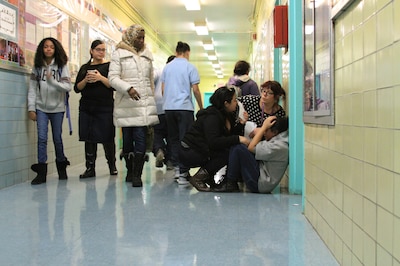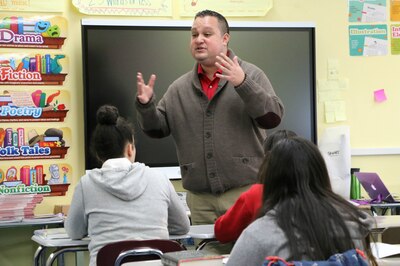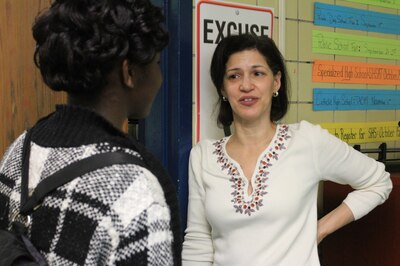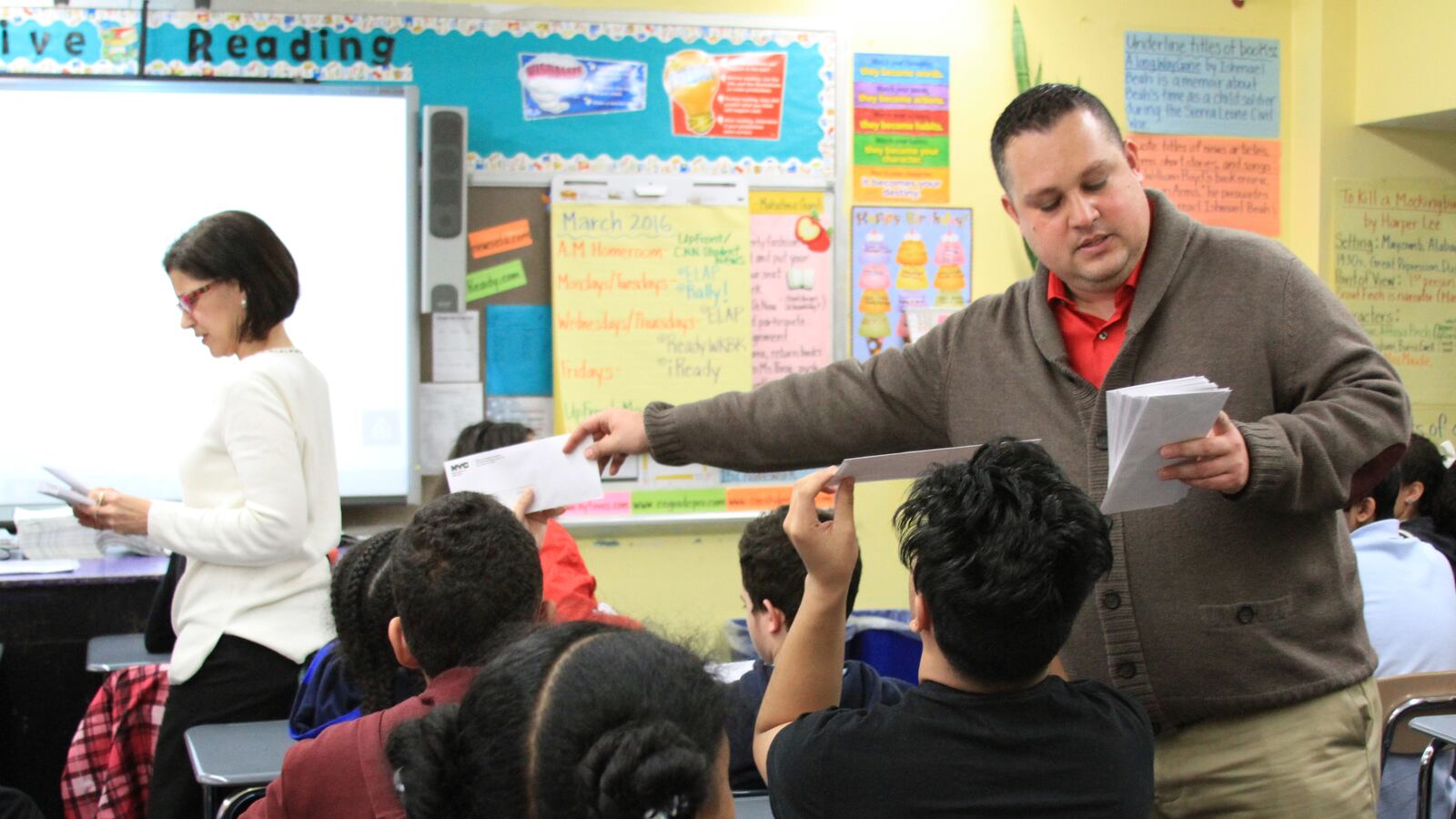The doors to the Bronx District 10 superintendent’s office had just parted Friday at 8 a.m. when Nancy Acosta arrived to collect her letters.
Acosta, the guidance counselor at M.S. 244 in the Kingsbridge section, was one of scores of staffers across the city who were responsible Friday for picking up boxes of high school offer letters and distributing them to some 76,500 anxious eighth-graders. The letters tell students which high school they have been matched with.
Few other days in the life of a 13-year-old New York City public school student can unleash such unbridled elation, or such crushing dejection. On that day, students find out whether they will attend a high school close to home or a distant train ride away, one whose arts or academic programs are renowned or unknown, one that helps catapult students toward college or struggles to get them to graduate.
Acosta, a former parent coordinator who went back to college to become a guidance counselor, had worked hard for this day. She’d taught students to decipher the 649-page high school directory, explained to parents how to help their children rank 12 schools on their applications from more than 700 options, and had hand delivered students’ work samples to the most competitive schools with the hope that doing so might give her students an edge.
Though she awoke early Friday to race to the letter pickup, she had stayed up late the night before checking an online database that allowed school employees to see whether any of her students had snagged spots in top schools. Around 11 p.m. Thursday she began texting M.S. 244’s principal, Eduardo Mora, with good news: Several students had won hotly desired seats.
But Friday was when Acosta and Mora would share the results with students, informing them where they were likely to spend their next four years — years that could steer the course of their lives.
“I get just as nervous as the kids,” Acosta said Friday morning. “Very nervous.”
Bad news first

A little after 10 a.m., Acosta led a small group of eighth-graders into Mora’s office. These were the unlucky ones.
“This happens every year. This is nothing to get crazy about,” Mora told the group, their eyes widening. “You’re going to get your letters. You did not get matched.”
This year, after applications were submitted in December and the education department ran its computerized matching algorithm, about 7 percent of students citywide were left without placements. Students who list the maximum 12 choices on their applications and who choose schools for which they are eligible can almost guarantee a match. Still, sometimes even students who submitted solid applications wind up without any offers.
“This is not your fault,” Mora said, as one student buried her head inside her folded arms on Mora’s conference table, and several girls standing behind her wiped tears from their eyes. “It’s not a reflection of you.”
Twenty-six out of more than 300 eighth-grade students at M.S. 244, also known as the New School for Leadership and the Arts, did not receive any offers. Now they must go through a second application round where they will choose from the leftover seats. Often, those spots are found at lower-performing schools that struggle to attract applicants, or they are at higher-performing schools but reserved for students with disabilities.
Acosta promised to stay late that afternoon to go through the list of “Round Two” seats with students, then she led them back to class. Mora began texting some of their parents, and one immediately called back.
“How’s it going?” Mora said, answering his cell phone. “This is a tough day here.”
A teachable moment

Around 11:30 a.m., Mora pulled open the door to a dimly lit seventh-grade classroom and stepped inside.
“Listen to me and listen to me good,” he said softly. The room went silent.
Students submit their high school applications in the winter of their eighth-grade year, but at M.S. 244, the process begins long before that.
Staffers start taking some students to visit private and Catholic high schools in sixth grade, explaining that many offer generous scholarships. In seventh grade, students learn to distinguish between screened and unscreened public high schools, start drafting the essays that some selective schools require, and compile tentative lists of choices.
This early start is crucial because, while the city’s massive high-school choice system lets any student apply to any school, many of the highest-performing and most sought-after schools screen their applicants. Aside from eight elite schools that accept students based on a single entrance exam, most selective schools review students’ grades, test scores, and attendance — from seventh grade.
“This afternoon, eighth period, keep your eyes and your ears open,” Mora told the class. “I want you to see what goes on with the eighth grade, because that will be you a year from now.”
He went on to explain that the older students would be receiving their high school placements that afternoon.
“Everything you do this year is going to have a direct impact on your high school admissions,” he told the 12-year-olds.
In another classroom where he gave this combined pep talk and cautionary tale, he reminded the seventh-graders that it was not too late to start showing up to school every day, getting better grades, and preparing for the state exams.
“There’s still time,” he said, heading toward the door. “Make sure you end this year on a high note.”
Letter time

Just before 2 p.m., Room 407 began rattling as dozens of fingers and pens played desktop drum rolls: Acosta and Mora were about to pass out the offer letters.
“It’s like Christmas sort of,” one boy said. “Can I use the bathroom?” another asked, hoping for some privacy when he read his letter.
In just a moment, many long months of poring over the high school directory, scouring school-review websites, and attending open houses — not to mention completing essays, interviews, and auditions for some ambitious students — would end with a dramatic finale.
It had been a taxing process for the students, but also for Mora and Acosta, who had to fill in for many parents who could not afford to take time off work, spoke little English, or were unfamiliar with the Byzantine application process.
Acosta had organized weekend application workshops for families, and sent home notes in Spanish with feedback on students’ school choices. She had reminded the students to plug important admissions dates into their smart-phone calendars, brought a dozen students whose parents were unavailable to an open house (which some schools require applicants to attend), and — with Mora — accompanied students to weekend auditions at faraway schools in Queens.
“If we don’t do that, we’re going to deny the kids an opportunity of actually having a shot,” Mora explained. “And we have some very talented kids.”
As the letters were handed out, students held their envelopes up to the fluorescent lights and tried to peer through. Finally, Acosta gave the order to open the envelopes and reveal their matches. There was frantic tearing, a moment of silence, then a girl’s piercing scream.
“I got into LaGuardia!” she shouted, referring to the famous performing arts schools in Manhattan where thousands of students audition for one of the coveted spots. The class erupted in cheers.
Then the emotions came flooding out: A girl sobbing with joy in Acosta’s arms; a different girl rushing into the hallway to unleash bitter tears. Students searched for classmates who had been matched with the same school, while teachers tried to reassure students who had been offered a third or fourth-ranked choice.
“These high schools make you feel like you’re a failure,” said Amy Carpio, who did not receive her top choice.
Yet when all the offers had been tallied, they reflected well on the arts-focused Bronx school, where 94 percent of students come from low-income families and one-fifth live in temporary housing. Four students had won spots at LaGuardia; five got offers to one of the elite “specialized” high schools; and several others won seats in extremely competitive selective schools such as Beacon High School in Manhattan, where more than 5,200 students applied for 320 spots last year.
In another eighth-grade classroom downstairs, Joel Lopez called his mother to let her know he’d received an offer at Bronx Theater High School. It wasn’t his first choice, but he said he still planned to celebrate.
“I’ll probably get myself some ice cream,” he said.
A little while later in the principal’s office, with the letters read and most tears dried, Acosta finally exhaled.
“It’s a sigh of relief,” she explained, “because these kids have worked very, very hard.”

